Roof Prism Vs Porro Prism Binoculars: Which One Should I Choose?
If you are looking for a binocular for your next exciting trip you might be confused about whether should I choose a Roof prism or Porro prism binoculars.
Also, you might have purchased a binocular and wanted to know whether its a Roof or Porro prism.
Here, I clear all the Jargons surrounding different aspects of prisms in a binocular.
Once you skim through this article you would be clearly understanding;
What is a prism in binoculars? What are the differences between Roof and Porro Prisms? and, Which type of prisms should I choose for my next binocular?
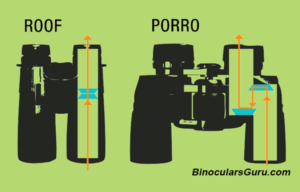
What is Prism?
A prism is an optical object made of transparent material like glass, plastic, and fluorite in an either triangular, hexagonal or rectangular shape.
Made up of 2 minimum polished plane faces that are inclined relative towards each other, and the prism helps reflect or refract light.
Prism made in the right angle redirects light at 90°, whereas a wedge prism refracts light. A prism can’t have any side which is curved and as such a prism is never in the cylinder, cone or sphere shape.
There are numerous types of prisms and they have a variety of applications in microscopes, lenses, laser diodes, rangefinders and many more.
Binoculars without a prism will make things look upside down and backward.
Moreover, The binoculars use prism to create a shorter optical path. This decreases the length of the binoculars and thus making it compact.
Binoculars are chiefly available in Roof Prism and Porro Prism categories, and a prism is used to correct the image orientation created by the lens.
If you have decided to go on a hiking, trekking, birdwatching trip with/without family; its better to choose a binocular equipped with any of the prism types.
Porro Prism Binoculars
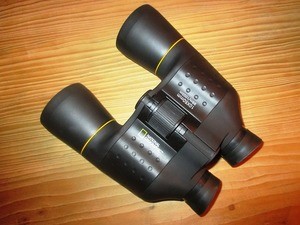
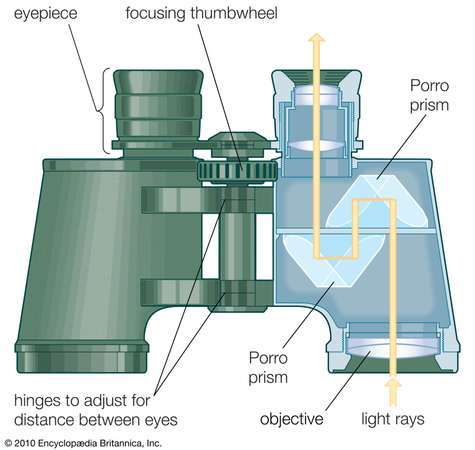
Porro Prism binoculars, named after its inventor, Ignazio Porro; are the most common type of binoculars; that a buyer can find in the market.
Double-Porro prism, shortened to ‘Porro’; these binoculars are larger and less expensive than roof prism binocular.
Ideally suited to use during a picnic or gathering, they are known for their good ergonomics and holding stability.
These type of arrangements are ideally suited for entry-level use
Its better performance than roof prism binocular makes them the most sought-after binocular for a user like you who intends to use it on a family picnic trip.
The zig-zag design of Porro prism binocular creates a clearer 3-D image with greater depth perception. Glass elements of these binocular are ideally meant to offset one another.
The easiest way to find out a Porro prism binocular for a first time user is that it has a narrower barrel that grows wider towards the outer objective lens.
Though it is more cumbersome than roof prism binocular, its’ less complex. The light path refracts more light, thereby allowing a brighter image and better optics to be visible.
Roof Prism Binocular
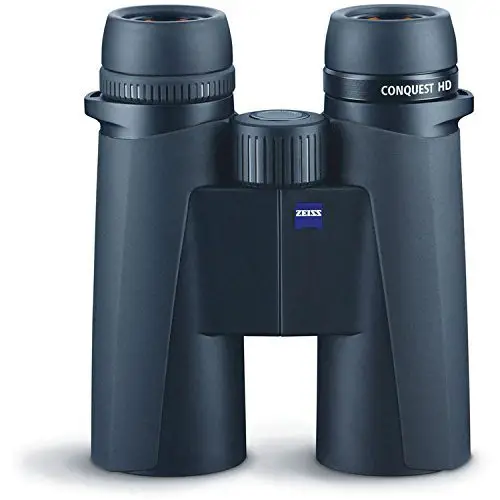
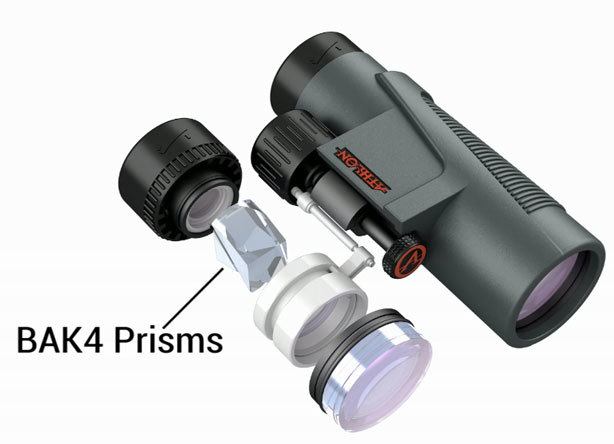
Roof prism binocular is more streamlined as the glasses are in line with one another. These are easy to hold for you, are more compact and more expensive than Porro Prism binoculars.
These binoculars; contain 2 prisms called Dach or Dachkanten prism, and derive their name from Abbe-Koenig (AK) prism design.
This design corrects an image horizontally and vertically while maintaining a straight line. If you are looking to go on a hiking or bird watching tour, this binocular is a must-have.
High precision characteristic denotes a roof prism binocular. These are straight barrelled, lightweight and more waterproof than Porro prism binoculars.
Built to last in a harsh environment, a roof prism binoculars’ central portion that connects the 2 tubes is either an open bridge or closed bridge design.
The open bridge design has a focus mechanism close to the eyepiece with the stabilizing section towards the objectives while the closed bridge design has an enclosed focus mechanism.
This allows for a better grip as well as reduced weight. There are three main types of roof prism binoculars namely Amici, Schmidt-Pechan and Abbe-Koenig.
Roof Prism Binoculars vs Porro Prism Binoculars – A Comparison
Roof Prism Binoculars | Porro Prism Binoculars | ||
1. | Increase in popularity after the introduction by Zeuss and Leitz. | 1. | Standard design in use till 1960s. |
2. | Compact, lightweight and comfortable to hold. | 2. | Heavier design, zig-zag shape, not so easy to grip. |
3. | More expensive due to higher manufacturing costs. | 3. | Less expensive. The highest quality ones are priced the same as normal roof prism binoculars. |
4. | Waterproof and durable design. | 4. | Less durable and not a waterproof design. |
5. | More powerful lens. | 5. | Less powerful lens. |
6. | The spotting scopes results in a more streamlined shape. | 6. | It offers greater depth perception and a wider field of view. |
7. | Prism alignment is in a straight line resulting in a straight barrel. | 7. | Prism alignment is in abstract line resulting in offset barrel. |
8. | Not every roof binocular can be fitted on a tripod. The open bridge can be easily mounted on a tripod while the closed bridge needs a special tripod. | 8. | Almost all types of Porro binocular can be mounted on a tripod. |
9. | Images are less stereoscopic. | 9. | Images are more stereoscopic. |
10. | The lens comes with a coating for better reflection. | 10. | The lens comes without coating but still provides almost reflection. |
11. | The distance between the eyepieces is too small. | 11. | The distance between eyepieces is much wider. |
12. | Suited for professional use like hunting and traveling. | 12. | Suited for recreational use like picnic watch. |
13. | It comes equipped with a special dielectric or coating. | 13. | It doesn’t have any silver coating. |
Roof Prism Binoculars vs Porro Prism Binoculars – Which is Better?
If you are looking to buy a binocular, more specifically when you have to choose between roof prism binoculars and Porro prism binoculars, you first take into consideration both of them and compare (as mentioned above).
Then choose from some of the established brands of binoculars namely Athlon, Bushnell, Carson, Canon, Gosky, Leupold, Vortex, Maven, Meopta, Nikon, Orion, Pentax, Swarovski, Wingspan, Zeiss and many more. All of these companies are well-known makers of both Porro prism as well as roof prism binoculars.
If you are looking for magnification, better go for binocular with a magnification of 7x to 10x; the most prevalent magnification level for a binocular.
If the price is your point of consideration and you are looking for a less expensive binocular, then better to go for Porro prism binoculars.
However, if you want to go for the best quality viewing experience then go for roof prism binoculars.
As roof prism binoculars are very expensive keep them out of kids’ reach. If that is not possible go for a roof prism binoculars specifically designed for kids.
As such both types of binoculars are equally good, but it all boils down to your requirement and pocket.
Ideally if looking for recreation go for Porro prism binocular, and for professional use, it’s better to go for a Roof prism binoculars.
If you are ready for your next binoculars check out our review of the→ Best Binoculars for Hunting

Very helpful, thank you